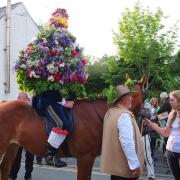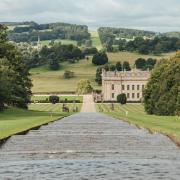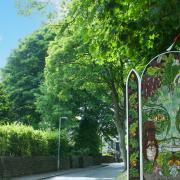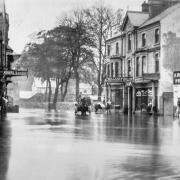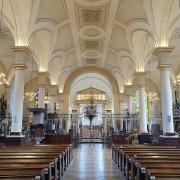‘Thankful villages’ which lost none of their men during one of the two World Wars are rare indeed. As Remembrance Day approaches we learn why Bradbourne has double the reason to be thankful.
Armistice Day and Remembrance Sunday are important dates on the calendar in my household.
My wife’s late father fought throughout the Second World War and saw action at Tobruk and El Alamein, so remembering has an added poignancy for us.
Going back even further, virtually every community in the UK suffered losses in the Great War of 1914-18, so their war memorials naturally become the focus of remembrance every November.
What of the small number of villages that do not have a memorial, though?

The term ‘Thankful Village’ dates back to the 1930s, when it was coined by journalist, editor and writer Arthur Mee (1875-1943) to describe a village that had lost no men in the Great War.
Of the 16,000 villages or so in England, Mee positively identified just 24 that could be called Thankful, whilst conjecturing that there could in fact be as many as 32, a figure that has since been adjusted up to 57 – still representing less than 0.5% of British villages.
To put that in perspective, there are no Thankful (or Blessed) villages in either Scotland or Northern Ireland, whilst it is thought that France’s only example is Thierville, in Normandy.
And there is only one such village in our county of Derbyshire; Bradbourne, four miles north-east of Ashbourne in the south-east of the picturesque Peak District - a remote hill-top village overlooking the narrow valley of the Havenhill Dale Brook.
Even rarer, there are only 14 villages in the whole of England and Wales that are ‘Doubly Thankful’, having had all its members of the armed services also survive World War II.
Bradbourne has been listed as quite possibly, or even probably, one of these Doubly Thankful villages.
The statistics are staggering and bring home fully the scale of loss from both World Wars, but from the Great War in particular.
When we journey through these beautiful islands, virtually all the places we come across do have a war memorial, but what of the places that do not? What, for example, should we make of a place such as Bradbourne?

The village’s All Saints Church is a tranquil spot with a south door that boasts one of the best-preserved Norman examples in Derbyshire, the village having been mentioned in Domesday Book.
There’s even greater antiquity in the churchyard through the presence of an 8th century Saxon cross, an old occupant of a churchyard that has poignant red poppies fluttering during the summer months.
The village also comes replete with a handsome parsonage and other Listed buildings of significance and interest.
Inside the aforementioned church are memorials to local worthies the Buckstons, one of whose number, Thomas Buckston, is commemorated as ‘one of the oldest officers in H.M. service’.
Indeed, it seems Bradbourne’s association with the armed forces goes way back.
A modern act of Remembrance is served by a simple wooden peg inside the church; on here a wreath is placed each year.
The Elizabethan Bradbourne Hall is built on the site of a grange that was once used by the monks of Dunstable Priory who farmed the hills around here.
The Bradbournes were once the lords of the manor here although their familial seat, Lea Hall, was actually around a mile or so outside of the village.
According to Mee, in Enchanted Land (1936), a total of 18 men left Bradbourne village to serve in the Great War. This was a considerable number and a high proportion of the able-bodied men in such a small, rural community. All mercifully returned safely.
The village’s population has never been high, peaking in the immediate post-Napoleonic era with 210 souls in 1821, just six years on from Waterloo.
A slow but steady decline had seen the headcount reduce to something approaching 120 in the early-21st century.
Bradbourne, of course, has no war memorial or indeed any roll of honour confirming that those 18 men served and survived so focus and attention has to be elsewhere at Remembrance time.
There is a Commonwealth war grave in the churchyard, but not of a villager. It’s the final resting place of Private Holmes, who actually hailed from the nearby village of Aldwark.
Holmes’ grave, a tangible symbol of loss, has understandably been the focus of Remembrance here in Novembers past, however his presence in the village does not in any way detract from Bradbourne’s proud status as a thankful village.
There’s also a memorial to the village’s good fortune in the form of a Victorian lamp on a base and pedestal in the square, which now bears a small plaque commemorating Bradbourne’s thankful village status, whilst the signs at the edge of the village also welcome us to a thankful village.

Lesley Greenleaf lived in the schoolhouse in the village, departing for Australia aged 16 where he joined up and then served with such distinction in the First World War.
He was awarded the MC (Military Cross) for bravery, returning to England for medical care after twice being wounded.
The MC was created in December 1914 and at the time was the second-level military decoration awarded in recognition of ‘an act or acts of exemplary gallantry during active operations against the enemy’ outranked only by the VC (Victoria Cross) for ‘the most conspicuous bravery’.
Although Greenleaf may be regarded as Bradbourne’s most famous military son, the others who served in the two World Wars undoubtedly had ‘the right stuff’ - be that courage, steadfastness or just a willingness to serve their country.
It’s very possible that some of the other 17 served in the Sherwood Foresters (Nottinghamshire and Derbyshire Regiment) whose battalions served on the Western Front and at Gallipoli.
When the Second World War came around just a generation later, Bradbourne would be blessed once again with a further 11 men returning home safely from the most destructive war in human history.
The Sherwood Foresters did their bit again, serving in the Norwegian Campaign and during the Battle of France, including at Dunkirk, as well as in North Africa, Italy and even the Far East.
With more than one million British personnel losing their lives across the two World Wars, it really is quite extraordinary to think that Bradbourne could have a total of 29 servicemen all come home safely.
Competence, leadership, luck, the grace of God, the will to survive, and sheer bloody-mindedness may well have all played their part.
Bradbourne can be proud of its rare status as a ‘Thankful Village’, for there is something about these fortunate communities that sets them apart but nevertheless also binds them together.
Bradbourne is also proud to join the citizens of this country each November, however, to remember those who were less fortunate.
For, whilst celebrating Bradbourne’s good fortune as Derbyshire’s sole thankful village, we must never lose sight of the bigger picture.
The villagers here are only too well aware of Bradbourne’s unique status within the county and the good fortune of their forebears, who bravely marched away to fight with every man Jack returning to tell the story.
In a sense, it’s a village that stands apart. Yet each November it’s very much a part of our Remembrance commemorations, remembering and honouring those in Derbyshire and across the country who fell during both World Wars.








